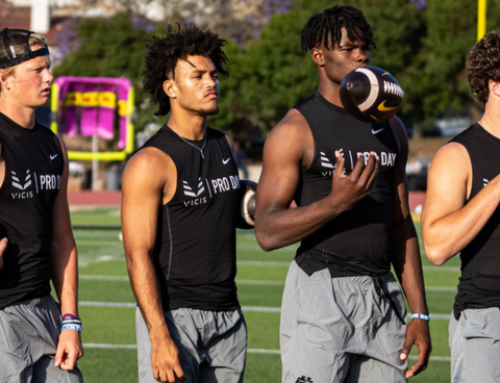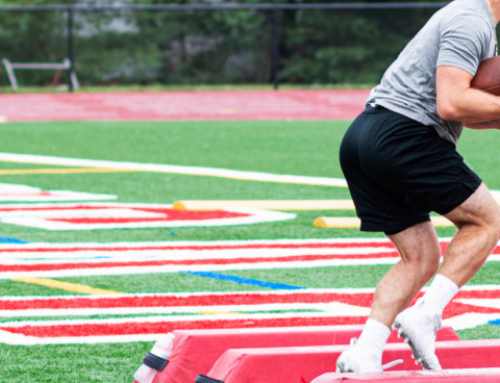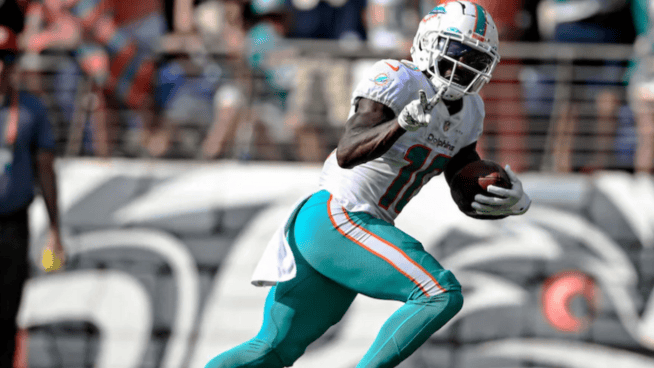Utah LB Pita Taumoepenu’s Incredible Journey From Tongan Fruit Farmer To NFL Draft Prospect
When Pita Taumoepenu caught his first glimpse of American football, he was 17 years old. He didn’t know a lick of English, but he knew he liked what he saw. “I was like, ‘damn, look at these people. they’re wearing helmets, banging into each other. This is crazy,” Taumoepenu told STACK.
A few short years later and Taumoepenu is now a legitimate prospect in the 2017 NFL Draft. His journey has been nothing short of improbable, and his miraculous transformation from a Tongan fruit farmer into one of the Pac-12’s most-feared sack artists happened in a flash. This is Pita Tauomoepenu’s incredible Path to the Pros.

Pita Taumpoenu (Photo by Ian Spanier)
Taumoepenu was born in what is perhaps the most football-obsessed state in America—Texas. But when he was 3 months old, his mother made the tough decision to send him to live in Tonga with his grandparents.
“My mom is a single mother. My dad has never been around in my life. My mom was working at the airport at that time so she really didn’t have enough time to take care of me, so I moved to Tonga with my grandparents,” Taumoepenu said.
Tonga is a Polynesian sovereign state composed of 169 islands in the south Pacific. Its total population is 103,036—about the size of Richmond, Virginia. Agriculture provides the majority of employment in Tonga, which was the case for Taumoepenu and his family. “I worked on my grandpa’s farm growing up. We grew manioke [a carbohydrate-rich tuber], taro, watermelons, pineapples,” Taumoepenu said. “My grandpa was a hard worker. He basically farmed for the whole village. He fed the whole village, and everyone knew it.” Seeing how hard his grandfather worked on the farm day in and day out instilled a relentless work ethic in Pita, who was named after him. As they worked on the farm together, Pita’s grandpa would often tell him that he would soon grow up to be a great athlete back in America.
RELATED: The Beast Inside Solomon Thomas is Coming For The NFL
“He’d tell me, ‘one day, you are going to go back to a country that’s bigger [than Tonga]. You’re going to play sports,” Taumoepenu said. “I kept saying, ‘hey Grandpa, we’re out here working on the farm. I don’t know what you’re talking about, but in the future I’m going to become like you, one of the biggest farmers in our village.’ I didn’t even know what he meant, but he kept saying it to me, so it kind of stuck in my mind.”
At the time, Pita didn’t even know that his grandpa was his grandpa—he believed he was his father. He also wasn’t aware that he’d been born inside the United States before he moved to Tonga.

Pita Taumpoenu doing Hammer Curls at Proactive Sports Performance. (Photo by Ian Spanier)
Though Taumoepenu might have regarded his grandpa’s predictions as far-fetched at first, he soon began dreaming of becoming a star athlete as a way to provide a better life for his family. He excelled at Tonga’s most popular sports—cricket and rugby. “The main reason I played sports was because I wanted something to help my family out. Trying to find a way I can get out of Tonga and go somewhere to get an opportunity to help my family out,” Taumoepenu said.
Playing rugby and working on the family farm helped Pita develop a muscular physique and blue-collar toughness. Those traits would soon come in handy.
When Pita was 17 years old, his mother decided to bring him back to the United States. But while his mom, sister and grandparents moved to Monterey, California, Pita moved to Provo, Utah, to live with an aunt and uncle. The family had three sports-loving boys, and Pita often hung out on the sidelines of their Little League practices. Across the street was a field where a local high school football team practiced.
“I remember always turning around and watching [football practice], and I started to like it,” said Taumoepenu. “I turned to my uncle and said, ‘Man, what are these people doing?’ He grabbed me and said, ‘that sport right there, if you work hard and become successful in it, they’ll be able to pay for your school. That way, your mom won’t have to pay for your school.’ My mom had done a lot of things for me in my life. She made me feel comfortable my whole life. I wanted a way to help her out. So I told myself, I wanted to do this sport.”
That was easier said than done. His uncle introduced him to the football coach of one nearby high school, but the staff wanted nothing to do with a kid who barely knew English and had zero football experience.
Taumoepenu said, “I told the coach all I wanted was an opportunity. He asked me if I’d ever played football before. I said ‘no.’ Then he was laughing and told me, ‘maybe you should just go home and play video games.’ The whole team was cracking up, laughing. I stood there looking at them, and I knew I was going to have to prove myself. Someway, somehow, I had to.”

Pita Taumpoenu between sets. (Photo by Ian Spanier)
“The very next day, my uncle enrolled me over at Timpview High School. I didn’t even know that Timpview was one of the best teams in Utah,” Taumoepenu said. “He wasn’t expecting me to make the team. Then one day, their coach [Cary Whittingham] stopped by after my chemistry class. He said, ‘Pita, you want to play football? I’d like to help you out.’ I was like, ‘Man, thank God for accepting my prayers. I’d been praying for that.’ That moment really changed my life.”
Pita began practicing with the team during the second half of his junior year, knowing he would have just one season at the high school level to prove his worth. His first football practice wasn’t exactly a highlight. “It was crazy,” he said. “My coach gave me the helmet and the pads, and I thought I was going to die. It was so heavy! He told me to just walk around the whole field while the team practiced. So I just walked around. That was my first practice.” Once he got acclimated to the gear, it was time for him to find a position. Whittingham told him to think over what role might suit him best. His inspiration came in the form of Green Bay Packers outside linebacker Clay Matthews.
“I was watching the Packers. Clay Matthews came off the edge at the time, and I remember seeing him hitting quarterbacks. I was like, ‘Man, I want to do this.’ So I started practicing his moves, his speed move and his countermove,” Taumoepenu said. “At the time, I didn’t even know what the positions were called. I went back to my coach and said, ‘hey, you know the buff guy with the long hair on Green Bay, number 52? I want to play that. I want to get the quarterback.’”
RELATED: The Clay Matthews Workout
Whittingham obliged, and he strived to unlock Pita’s athleticism by simplifying his duties. He made his objective simple—hit the quarterback. “He helped me play fast without thinking too much. He told me to line up on the edge and go get the quarterback,” Taumoepenu said. As it turned out, Pita was very good at hitting quarterbacks. He racked up four sacks in his first high school game. At the time, he didn’t realize how rare a feat that was. “I didn’t even realize that a sack was a really good thing. I thought it was just another tackle or whatever. So I just kept going and hitting the quarterback,” Pita said. By the time Timpview reached the 2012 Utah 4A state championship game, Taumoepenu had racked up an astonishing 21 sacks.

Pita Taumpoenu trains his shoulders and back. (Photo by Ian Spanier)
The night before the state championship game, tragedy struck—Pita’s grandpa passed away. With a heavy heart, Pita recorded four sacks—including one to end the game in overtime—to propel Timpview to the title. The next day, he received an offer from BYU.
“I was trying to get a scholarship so I could show him and say, ‘hey, you were right.’ It’s probably the thing I’m going to regret my entire life—I never got to let him know that he was right. He told me that one day I’m going to come back and start playing a sport and go to school,” Taumoepenu said. “Every time I do something that’s good, I picture him having a smile on his face, looking down on me.”
Pita’s 25-sack season earned him first-team All-State honors and a spot on USA Today’s All-Utah team. Not bad for a dude who didn’t even know how to put on his shoulder pads just a few months earlier. Pita’s pass-rushing prowess attracted a number of college programs in addition to BYU, including Utah State, Utah and Hawaii. In the end, it was the Utes who won him over.
The transition was far from seamless. The jump to D-I football is often startling for all but the most polished of prospects, and Pita was as raw as they come.
“From high school, all I knew was to just come off the ball. I used to just fly off the ball. I learned a lot,” Taumoepenu said. To make matters even more challenging, he wasn’t allowed to practice or play in any games for the first month of his freshman season due to paperwork involved with attending high school in two separate countries. Despite such obstacles, Pita dedicated himself to improving his football IQ and refining his technique. “Rugby, you just go with the flow. Football, there are a lot of assignments and things you have to do. It helps me as a football player, but also in life. You have to solve something. That’s what I like about football,” Taumoepenu said. “How much film are you going to watch? It’s all up to you.”
RELATED: Is JUCO Football Right For Me?
His work ethic helped him get on the field for seven games during his true freshman season, and he recorded six tackles, two TFLs and a sack en route to his first letter. He continued to progress in his sophomore season, appearing in 13 games and recording 5.5 sacks. By the time he stepped on the field as a junior, Pita had a much better idea of not only his own assignment, but what was going on around him. “My junior and senior years, I learned what everybody on the defense does. I learned the ‘fit,’so I knew where to force the ball and where the help was,” Taumoepenu said.

Taumpoenu played linebacker for the University of Utah. (Photo: Getty Images)
He also learned the finer points of rushing the quarterback, as opposed to just “flying” upfield. “I like a lot of moves. I like the speed rush and the spin move. In order to beat a tackle with speed, you have to scare him. Basically, if I widen out a bit, he’s going to cheat out. Then if I beat him with an outside speed rush, I know he’s going to try to cheat next time. He’s going to jump outside. I’m going to read it. If I feel him coming heavy outside, I can hit him with the spin. If I feel like he’s just sitting back, I can go from a speed rush to a power rush,” Taumoepenu said..
It all came together for Pita during his senior season at Utah. He racked up 9 sacks, 12 tackles for loss and three forced fumbles on his way to All-Pac-12 Honorable Mention honors.
[youtube video=”Bhct48r0RqM”]He had a solid showing at the 2017 NFL Combine, highlighted by his lightning-fast 6.91 3-Cone Drill. That was the fifth-fastest time among linebackers, and the 3-Cone Drill has traditionally been a strong indicator of a pass rusher’s NFL potential. Moving swiftly and fluidly through the cones is a great test of acceleration, body control, agility and balance—all incredibly important attributes for a pass rusher.
It’s not just Pita’s athleticism that has pro scouts intrigued. His unrelenting effort also pops on film. From his NFL.com scouting report: “Plays with terrific urgency and a motor that is always humming. Relentless in his pursuit with a good closing burst to the ball no matter where he is on the field.”
RELATED: The 5 Traits The Create an Elite Pass-Rusher
Taumoepenu’s relentlessness was instilled in him by his grandpa, who seemingly never got tired while working on the farm. “I remember working one time, and I was really tired. But I looked at my grandpa, he was still working so hard. He could have just farmed enough for our family and stopped, but he was doing it for the whole village,” Taumoepenu said. “If my grandpa stopped working, everyone was going to be hungry.”

Pita Taumpoenu. (Photo by Ian Spanier)
With Pita on the verge of an NFL career, his family is understandably excited. He talks to his extended family back in Tonga on a daily basis, and he makes a trip back every Christmas. He’s made a habit of bringing candy-stuffed suitcases on these trips, so he has presents for everyone in the village. “Growing up in Tonga, we got nothing on Christmas. We’d make food, pray, eat the food. That was our Christmas. But we’d always be happy. As a kid in Tonga, if you have candy, it was like you’re rich,” Taumoepenu said. “So I always bring like three suitcases filled with candy with me.”
Family is Pita’s motivation. He knows that if he can make a career for himself in the NFL, he can provide a better life for those who’ve been with him from the start. “I feel like I’m here for a reason. To help my family out. I feel like I have the energy and the passion and everything to make it happen. I just gotta find a way,” Taumoepenu said. “My grandpa always told me, ‘you can be whoever you want to become in this life. It’s up to you if you want to put in the work and the sacrifice.’”
See More From Our Path To The Pros Series
RECOMMENDED FOR YOU
MOST POPULAR
Utah LB Pita Taumoepenu’s Incredible Journey From Tongan Fruit Farmer To NFL Draft Prospect
When Pita Taumoepenu caught his first glimpse of American football, he was 17 years old. He didn’t know a lick of English, but he knew he liked what he saw. “I was like, ‘damn, look at these people. they’re wearing helmets, banging into each other. This is crazy,” Taumoepenu told STACK.
A few short years later and Taumoepenu is now a legitimate prospect in the 2017 NFL Draft. His journey has been nothing short of improbable, and his miraculous transformation from a Tongan fruit farmer into one of the Pac-12’s most-feared sack artists happened in a flash. This is Pita Tauomoepenu’s incredible Path to the Pros.

Pita Taumpoenu (Photo by Ian Spanier)
Taumoepenu was born in what is perhaps the most football-obsessed state in America—Texas. But when he was 3 months old, his mother made the tough decision to send him to live in Tonga with his grandparents.
“My mom is a single mother. My dad has never been around in my life. My mom was working at the airport at that time so she really didn’t have enough time to take care of me, so I moved to Tonga with my grandparents,” Taumoepenu said.
Tonga is a Polynesian sovereign state composed of 169 islands in the south Pacific. Its total population is 103,036—about the size of Richmond, Virginia. Agriculture provides the majority of employment in Tonga, which was the case for Taumoepenu and his family. “I worked on my grandpa’s farm growing up. We grew manioke [a carbohydrate-rich tuber], taro, watermelons, pineapples,” Taumoepenu said. “My grandpa was a hard worker. He basically farmed for the whole village. He fed the whole village, and everyone knew it.” Seeing how hard his grandfather worked on the farm day in and day out instilled a relentless work ethic in Pita, who was named after him. As they worked on the farm together, Pita’s grandpa would often tell him that he would soon grow up to be a great athlete back in America.
RELATED: The Beast Inside Solomon Thomas is Coming For The NFL
“He’d tell me, ‘one day, you are going to go back to a country that’s bigger [than Tonga]. You’re going to play sports,” Taumoepenu said. “I kept saying, ‘hey Grandpa, we’re out here working on the farm. I don’t know what you’re talking about, but in the future I’m going to become like you, one of the biggest farmers in our village.’ I didn’t even know what he meant, but he kept saying it to me, so it kind of stuck in my mind.”
At the time, Pita didn’t even know that his grandpa was his grandpa—he believed he was his father. He also wasn’t aware that he’d been born inside the United States before he moved to Tonga.

Pita Taumpoenu doing Hammer Curls at Proactive Sports Performance. (Photo by Ian Spanier)
Though Taumoepenu might have regarded his grandpa’s predictions as far-fetched at first, he soon began dreaming of becoming a star athlete as a way to provide a better life for his family. He excelled at Tonga’s most popular sports—cricket and rugby. “The main reason I played sports was because I wanted something to help my family out. Trying to find a way I can get out of Tonga and go somewhere to get an opportunity to help my family out,” Taumoepenu said.
Playing rugby and working on the family farm helped Pita develop a muscular physique and blue-collar toughness. Those traits would soon come in handy.
When Pita was 17 years old, his mother decided to bring him back to the United States. But while his mom, sister and grandparents moved to Monterey, California, Pita moved to Provo, Utah, to live with an aunt and uncle. The family had three sports-loving boys, and Pita often hung out on the sidelines of their Little League practices. Across the street was a field where a local high school football team practiced.
“I remember always turning around and watching [football practice], and I started to like it,” said Taumoepenu. “I turned to my uncle and said, ‘Man, what are these people doing?’ He grabbed me and said, ‘that sport right there, if you work hard and become successful in it, they’ll be able to pay for your school. That way, your mom won’t have to pay for your school.’ My mom had done a lot of things for me in my life. She made me feel comfortable my whole life. I wanted a way to help her out. So I told myself, I wanted to do this sport.”
That was easier said than done. His uncle introduced him to the football coach of one nearby high school, but the staff wanted nothing to do with a kid who barely knew English and had zero football experience.
Taumoepenu said, “I told the coach all I wanted was an opportunity. He asked me if I’d ever played football before. I said ‘no.’ Then he was laughing and told me, ‘maybe you should just go home and play video games.’ The whole team was cracking up, laughing. I stood there looking at them, and I knew I was going to have to prove myself. Someway, somehow, I had to.”

Pita Taumpoenu between sets. (Photo by Ian Spanier)
“The very next day, my uncle enrolled me over at Timpview High School. I didn’t even know that Timpview was one of the best teams in Utah,” Taumoepenu said. “He wasn’t expecting me to make the team. Then one day, their coach [Cary Whittingham] stopped by after my chemistry class. He said, ‘Pita, you want to play football? I’d like to help you out.’ I was like, ‘Man, thank God for accepting my prayers. I’d been praying for that.’ That moment really changed my life.”
Pita began practicing with the team during the second half of his junior year, knowing he would have just one season at the high school level to prove his worth. His first football practice wasn’t exactly a highlight. “It was crazy,” he said. “My coach gave me the helmet and the pads, and I thought I was going to die. It was so heavy! He told me to just walk around the whole field while the team practiced. So I just walked around. That was my first practice.” Once he got acclimated to the gear, it was time for him to find a position. Whittingham told him to think over what role might suit him best. His inspiration came in the form of Green Bay Packers outside linebacker Clay Matthews.
“I was watching the Packers. Clay Matthews came off the edge at the time, and I remember seeing him hitting quarterbacks. I was like, ‘Man, I want to do this.’ So I started practicing his moves, his speed move and his countermove,” Taumoepenu said. “At the time, I didn’t even know what the positions were called. I went back to my coach and said, ‘hey, you know the buff guy with the long hair on Green Bay, number 52? I want to play that. I want to get the quarterback.’”
RELATED: The Clay Matthews Workout
Whittingham obliged, and he strived to unlock Pita’s athleticism by simplifying his duties. He made his objective simple—hit the quarterback. “He helped me play fast without thinking too much. He told me to line up on the edge and go get the quarterback,” Taumoepenu said. As it turned out, Pita was very good at hitting quarterbacks. He racked up four sacks in his first high school game. At the time, he didn’t realize how rare a feat that was. “I didn’t even realize that a sack was a really good thing. I thought it was just another tackle or whatever. So I just kept going and hitting the quarterback,” Pita said. By the time Timpview reached the 2012 Utah 4A state championship game, Taumoepenu had racked up an astonishing 21 sacks.

Pita Taumpoenu trains his shoulders and back. (Photo by Ian Spanier)
The night before the state championship game, tragedy struck—Pita’s grandpa passed away. With a heavy heart, Pita recorded four sacks—including one to end the game in overtime—to propel Timpview to the title. The next day, he received an offer from BYU.
“I was trying to get a scholarship so I could show him and say, ‘hey, you were right.’ It’s probably the thing I’m going to regret my entire life—I never got to let him know that he was right. He told me that one day I’m going to come back and start playing a sport and go to school,” Taumoepenu said. “Every time I do something that’s good, I picture him having a smile on his face, looking down on me.”
Pita’s 25-sack season earned him first-team All-State honors and a spot on USA Today’s All-Utah team. Not bad for a dude who didn’t even know how to put on his shoulder pads just a few months earlier. Pita’s pass-rushing prowess attracted a number of college programs in addition to BYU, including Utah State, Utah and Hawaii. In the end, it was the Utes who won him over.
The transition was far from seamless. The jump to D-I football is often startling for all but the most polished of prospects, and Pita was as raw as they come.
“From high school, all I knew was to just come off the ball. I used to just fly off the ball. I learned a lot,” Taumoepenu said. To make matters even more challenging, he wasn’t allowed to practice or play in any games for the first month of his freshman season due to paperwork involved with attending high school in two separate countries. Despite such obstacles, Pita dedicated himself to improving his football IQ and refining his technique. “Rugby, you just go with the flow. Football, there are a lot of assignments and things you have to do. It helps me as a football player, but also in life. You have to solve something. That’s what I like about football,” Taumoepenu said. “How much film are you going to watch? It’s all up to you.”
RELATED: Is JUCO Football Right For Me?
His work ethic helped him get on the field for seven games during his true freshman season, and he recorded six tackles, two TFLs and a sack en route to his first letter. He continued to progress in his sophomore season, appearing in 13 games and recording 5.5 sacks. By the time he stepped on the field as a junior, Pita had a much better idea of not only his own assignment, but what was going on around him. “My junior and senior years, I learned what everybody on the defense does. I learned the ‘fit,’so I knew where to force the ball and where the help was,” Taumoepenu said.

Taumpoenu played linebacker for the University of Utah. (Photo: Getty Images)
He also learned the finer points of rushing the quarterback, as opposed to just “flying” upfield. “I like a lot of moves. I like the speed rush and the spin move. In order to beat a tackle with speed, you have to scare him. Basically, if I widen out a bit, he’s going to cheat out. Then if I beat him with an outside speed rush, I know he’s going to try to cheat next time. He’s going to jump outside. I’m going to read it. If I feel him coming heavy outside, I can hit him with the spin. If I feel like he’s just sitting back, I can go from a speed rush to a power rush,” Taumoepenu said..
It all came together for Pita during his senior season at Utah. He racked up 9 sacks, 12 tackles for loss and three forced fumbles on his way to All-Pac-12 Honorable Mention honors.
[youtube video=”Bhct48r0RqM”]He had a solid showing at the 2017 NFL Combine, highlighted by his lightning-fast 6.91 3-Cone Drill. That was the fifth-fastest time among linebackers, and the 3-Cone Drill has traditionally been a strong indicator of a pass rusher’s NFL potential. Moving swiftly and fluidly through the cones is a great test of acceleration, body control, agility and balance—all incredibly important attributes for a pass rusher.
It’s not just Pita’s athleticism that has pro scouts intrigued. His unrelenting effort also pops on film. From his NFL.com scouting report: “Plays with terrific urgency and a motor that is always humming. Relentless in his pursuit with a good closing burst to the ball no matter where he is on the field.”
RELATED: The 5 Traits The Create an Elite Pass-Rusher
Taumoepenu’s relentlessness was instilled in him by his grandpa, who seemingly never got tired while working on the farm. “I remember working one time, and I was really tired. But I looked at my grandpa, he was still working so hard. He could have just farmed enough for our family and stopped, but he was doing it for the whole village,” Taumoepenu said. “If my grandpa stopped working, everyone was going to be hungry.”

Pita Taumpoenu. (Photo by Ian Spanier)
With Pita on the verge of an NFL career, his family is understandably excited. He talks to his extended family back in Tonga on a daily basis, and he makes a trip back every Christmas. He’s made a habit of bringing candy-stuffed suitcases on these trips, so he has presents for everyone in the village. “Growing up in Tonga, we got nothing on Christmas. We’d make food, pray, eat the food. That was our Christmas. But we’d always be happy. As a kid in Tonga, if you have candy, it was like you’re rich,” Taumoepenu said. “So I always bring like three suitcases filled with candy with me.”
Family is Pita’s motivation. He knows that if he can make a career for himself in the NFL, he can provide a better life for those who’ve been with him from the start. “I feel like I’m here for a reason. To help my family out. I feel like I have the energy and the passion and everything to make it happen. I just gotta find a way,” Taumoepenu said. “My grandpa always told me, ‘you can be whoever you want to become in this life. It’s up to you if you want to put in the work and the sacrifice.’”













